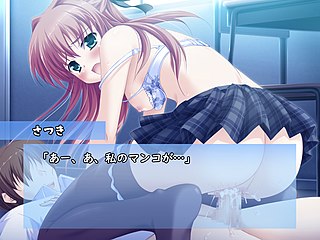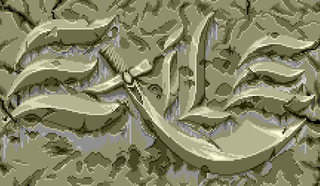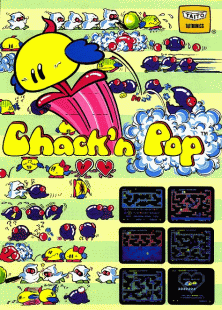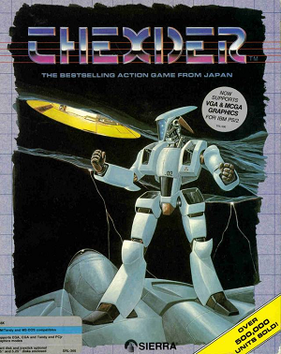
Donkey Kong 3 is a shooter video game developed and published by Nintendo. It is the third installment in the Donkey Kong series and was released for arcades worldwide in 1983, the Family Computer in 1984, then in North America for the Nintendo Entertainment System in 1986. The gameplay departs from previous Donkey Kong games, and it stars an exterminator named Stanley instead of Mario. The game was a modest financial success in Japan, but its commercial failure in the United States rendered the Donkey Kong series inactive until the release of Donkey Kong (1994) and Donkey Kong Country.
Enix Corporation was a Japanese multimedia publisher who handled and oversaw video games, manga, guidebooks, and merchandise. It was founded in 1975 by Yasuhiro Fukushima as Eidansha Boshu Service Center, initially as a tabloid publisher and later attempting to branch into real estate management. Beginning in 1982, Enix began publishing video games. Notable early collaborators were designers Yuji Horii and Koichi Nakamura, artist Akira Toriyama, and composer Koichi Sugiyama. Horii, Nakamura, Toriyama, and Sugiyama would all work on the 1986 role playing video game Dragon Quest for the Family Computer; one of the earliest successful RPGs for consoles, it spawned a franchise of the same name which remained Enix's best-known product.

An eroge, also called an H-game, is a Japanese genre of erotic video game. The term encompasses a wide variety of Japanese games containing erotic content across multiple genres. The first eroge were created in the 1980s, and many well-known companies in the Japanese gaming industry originally produced and distributed them. Some eroge are primarily focused on erotic content, while others, such as Key's Kanon, only contain occasional scenes in an otherwise non-erotic work. Games in the latter category are often re-released with sexual content removed for general audiences. Throughout its history, the genre has faced controversy for its use of explicit sexual content, and as a result has been banned from several console platforms.

The PC-8800 series, commonly shortened to PC-88, are a brand of Zilog Z80-based 8-bit home computers released by Nippon Electric Company (NEC) in 1981 and primarily sold in Japan.

Yuzo Koshiro is a Japanese composer and sound programmer. He is often regarded as one of the most influential innovators in chiptune and video game music, producing music in a number of genres including rock, jazz, symphonic, and various electronic genres such as house, electro, techno, trance, and hip hop.
Technosoft was a Japanese video game developer and publisher based headquartered in Sasebo, Nagasaki. Also known as "Tecno Soft", the company was founded in February 1980 as Sasebo Microcomputer Center, before changing its name to Technosoft in 1982. The company primarily dealt with software for Japanese personal computers, including graphic toolsets and image processing software. Technosoft's first venture into the video game market was Snake & Snake, released in 1982, before seeing success with titles such as Thunder Force (1983) and Plasma Line (1984).
Sexual content has been found in video games since the early days of the industry, and games featuring sexual content can be found on most platforms and can be of any video game genre.

The PC-9800 series, commonly shortened to PC-98 or simply 98, is a lineup of Japanese 16-bit and 32-bit personal computers manufactured by NEC from 1982 to 2003. While based on Intel processors, it uses an in-house architecture making it incompatible with IBM clones; some PC-98 computers used NEC's own V30 processor. The platform established NEC's dominance in the Japanese personal computer market, and, by 1999, more than 18 million units had been sold. While NEC did not market these specific machines in the West, it sold the NEC APC series, which had similar hardware to early PC-98 models.

Exile (エグザイル, Eguzairu, originally stylized XZR) is an action role-playing video game series developed by Telenet Japan. The first two games in the series, XZR and XZR II were both released in Japan in 1988, with versions available for the NEC PC-8801, NEC PC-9801, MSX2 and the X1 turbo (for the first game only). In 1991, a remake of XZR II simply titled Exile was released for the PC Engine and Mega Drive. These versions were both released in North America the following year, with Working Designs handling the localization for the TurboGrafx-CD version, while Renovation Products published the Genesis version. A sequel exclusive to the Super CD-ROM2 format, titled Exile: Wicked Phenomenon, was released in 1992, which was also localized by Working Designs for the North American market.

Bomberman is a maze video game developed and published by Hudson Soft. The original home computer game Bomber Man was released in July 1983 for the NEC PC-8801, NEC PC-6001 mkII, Fujitsu FM-7, Sharp MZ-700, Sharp MZ-2000, Sharp X1 and MSX in Japan, and a graphically modified version for the MSX and ZX Spectrum in Europe as Eric and the Floaters. A sequel, 3-D Bomberman, was produced. In 1985, Bomberman was released for the Nintendo Entertainment System. It spawned the Bomberman series with many installments building on its basic gameplay.

Chack'n Pop is a platform arcade game developed and released by Taito in 1984. In the game, the player controls a small yellow creature, Chack'n, with the objective being to retrieve hearts from a cave, all while avoiding the enemies contained within them. Chack'n also has the ability to deploy bombs, which can kill said enemies, which can bring bonuses depending on if all or none of the enemies have been killed.

Thexder is a run and gun video game from Game Arts, originally released for the NEC PC-8801 in 1985. It was ported to many systems, including the Famicom, MSX, Apple II and DOS. It was a commercial success, selling over one million units worldwide.

Jesus is a graphic adventure game developed and published by Enix. It was first released in 1987 on the PC-8801, FM-77AV, X1, and the MSX2 and was later ported to the Famicom in 1989 as Jesus: Kyōfu no Bio Monster. A sequel, Jesus II, was released on the PC-8801, PC-9801, and X68000 in 1991.

Hydlide is an action role-playing game developed and published by T&E Soft. It was originally released for the NEC PC-6001 and PC-8801 computers in 1984, in Japan only; ports for the MSX, MSX2, FM-7 and NEC PC-9801 were released the following year. A Nintendo Switch port based on the PC-8801 version was released on December 21, 2023 by D4 Enterprise.
Koichi Nakamura is a Japanese video game designer. Nakamura gained fame as a programming prodigy while still in high school; in 1982, he entered Enix's first national programming contest and claimed runner-up prize with his entry, Door Door. In 1984, he founded the video game company Chunsoft.

Door Door is a single-screen puzzle-platform game by Enix published in Japan in 1983. Originally released for the NEC PC-8801, it was ported to other platforms, including the Family Computer. Controlling a small character named Chun, the player is tasked with completing each stage by trapping different kinds of aliens behind sliding doors. Chun can jump over the aliens and climb ladders, and must also avoid obstacles such as large nails and bombs.

Valis II is a 1989 action-platform video game originally developed by Laser Soft, published by Telenet Japan and NEC for the PC Engine CD-ROM²/TurboGrafx-CD. A home computer version was released for PC-8801, MSX2, PC-9801 and X68000. A super deformed-style remake was also released in 1992 for the Sega Mega Drive/Genesis. It is the second entry in the eponymous series. It stars Yuko Asou, a Japanese schoolgirl teenager chosen to become the Valis warrior by wielding the titular mystical sword, after defeating the demon lord Rogles. The dream world Vecanti fell under the rule of emperor Megas, whose hatred towards his brother Rogles and bloodthirsty tendencies seeks to wipe out traces of the former tyrant, including his supporters. Gameplay varies between each version but all share similar elements, as the player explores and search for items and power-ups, while fighting enemies and defeat bosses.

The Earth Fighter Rayieza is a role-playing video game developed and published by Enix. It was originally published in 1985 for the PC-8801, FM-7, X1, and MSX personal computer systems. The game was ported to the Famicom on December 15, 1987 by Nintendo under the title Ginga no Sannin (銀河の三人). The programming was done by Pax Softnica.
Kazuro Morita was a Japanese video game designer known for his work on the Morita's Shogi video game series. Becoming interested in computer programming during high school, he entered magazine competitions during his university years, creating video game versions of board games. He won a competition organised by Enix in 1982 with the video game Morita's Battlefield, which was published the following year to great commercial success.

Kagirinaki Tatakai is a platformer/shooter game developed by Hiroshi Ishikawa and published by Enix exclusively for the Sharp X1 in Japan. Gameplay involves the player descending a vertical, underground shaft while facing enemies and projectiles. Equipped with a jet pack for maneuvering in the air, the player can engage adversaries with a raygun, a rocket launcher, or bombs. The latter two weapons can also destroy any portion of the stage for the player to create cover or to dig out new paths to advance.















